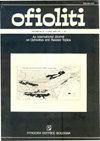在地球化学和岩石学的约束下,克罗地亚北部萨瓦-瓦尔达缝合带东北端蛇绿岩中玄武岩的构造-岩浆对比
IF 1.3
4区 地球科学
Q2 GEOLOGY
引用次数: 17
摘要
Kalnik和Ivanscica山的蛇绿岩混杂岩构成Kalnik单元的北段,代表了Sava- Vardar缝合带的最东北暴露尖端。岩石学;混杂岩中挤压岩块的地球化学和同位素特征特别是枕玄武岩变细碧岩;与放射虫cherts有关;把岩石分成五个不同的组。每个组都有一个年龄标记,其依据是相关燧石中的放射虫组合和/或同位素定年;以及以前公布的关于卡尔尼克单位的数据;详细分析了梅利亚塔-马里亚克洋系的一部分雷普诺洋域大约80 Ma的地球动力学演化。岩石类群为:(1)晚安西期碱性玄武岩[(La/Lu)cn = 5.9 ~ 7.2];eNd(T) = +2.96;Cpx-TiO2 = 3-6wt%]与陆内裂陷末期有关;(2)富集e - morb型玄武岩[(La/Lu)cn = 2.4 ~ 2.8];eNd(T) = +4.74;Cpx-TiO2 = 2.1 ~ 2.9wt%]和贫e - morb型玄武岩[(La/Lu)cn ~ 1.5];eNd(T) = +5.26;Cpx- TiO2 = 1.9 ~ 2.3wt%],反映了拉底世早期和拉底世晚期在海脊形成的连续的原洋壳;分别;(3)中卡尼世t - morb型玄武岩[(La/Sm)cn = 0.79 ~ 0.87];eNd(T) = +6.63;Cpx-TiO2 = 1.2-2.2wt%];代表地壳来自一个演化的扩张中心;(4) NMORB型玄武岩[(La/Sm)cn = 0.67 ~ 0.87];eNd(T) = +6.58;Cpx-TiO2 = 0.6 ~ 1.9wt%]具有继承的超俯冲特征,从晚卡尼期玄武岩[(Nb/La)n = 0.81]到巴约仙期玄武岩[(Nb/La)n = 1.1]逐渐减弱;中侏罗世(Bathonian?)n - morb型玄武岩具有反复俯冲相关影响[Nb/La] n = 0.72;(La/Sm)cn = 0.76;eNd(T) = +6.23];(5)晚Bathonian medium-Ti [(Nb/La)n = 0.24 ~ 0.72;eNd(T) = +6.30;Cpx-TiO2 = 0.6 ~ 1.1wt%]到晚牛津期低ti iat型玄武岩[(Nb/La)n = 0.12 ~ 0.22];eNd(T) = +6.31;Cpx-TiO2 = 0.2-0.6wt%],反映了伸展原弧环境下交代和连续衰竭的地幔楔的熔融体。本文章由计算机程序翻译,如有差异,请以英文原文为准。
A Tectono-magmatic correlation of basaltic rocks from ophiolite mélanges at the North-Eastern tip of the Sava-Vardar suture Zone, Northern Croatia, constrained by geochemistry and petrology
Ophiolite melanges of Mts. Kalnik and Ivanscica form the northern sector of the Kalnik Unit and represent the northeasternmost exposed tip of the Sava- Vardar Suture Zone. Petrological; geochemical and isotopic characteristics of extrusive rock blocks incorporated in the melanges; particularly of pillow basalt altered to spilite; in association with radiolarian cherts; allow the rocks to be separated into five distinct groups. Each group has an age-marker based on the radiolarian assemblage in the associated cherts and/or on isotope dating which; along with previously published data on the Kalnik Unit; provide detailed analysis of the approximately 80 Ma long geodynamic evolution of the Repno Oceanic Domain - a part of the Meliata-Maliak ocean system. The rock groups are: (1) Late Anisian alkali basalts [(La/Lu)cn = 5.9-7.2; eNd(T) = +2.96; Cpx-TiO2 = 3-6wt%] related to a terminal phase of intracontinental rifting; (2) enriched E-MORB-type basalts [(La/Lu)cn = 2.4-2.8; eNd(T) = +4.74; Cpx-TiO2 = 2.1-2.9wt%] and depleted E-MORB-type basalts [(La/Lu)cn ~ 1.5; eNd(T) = +5.26; Cpx- TiO2 = 1.9-2.3wt%] which reflect successive proto-oceanic crust formed at the ridge during the early Ladinian and late Ladinian; respectively; (3) middle Carnian T-MORB-type basalts [(La/Sm)cn = 0.79-0.87; eNd(T) = +6.63; Cpx-TiO2 = 1.2-2.2wt%]; representing crust from an evolved spreading center; (4) NMORB- type basalts [(La/Sm)cn = 0.67-0.87; eNd(T) = +6.58; Cpx-TiO2 = 0.6-1.9wt%] with inherited supra-subduction signature that diminish from the Late Carnian basalts [(Nb/La)n = 0.81] to the Bajocian basalts [(Nb/La)n = 1.1]; and Middle Jurassic (Bathonian?) N-MORB-type basalts with recurrent subduction related influence [Nb/La)n = 0.72; (La/Sm)cn = 0.76; eNd(T) = +6.23]; (5) late Bathonian medium-Ti [(Nb/La)n = 0.24-0.72; eNd(T) = +6.30; Cpx-TiO2 = 0.6- 1.1wt%] to late Oxfordian low-Ti IAT-type basalts [(Nb/La)n = 0.12-0.22; eNd(T) = +6.31; Cpx-TiO2 = 0.2-0.6wt%] which reflect melts derived from a metasomatized and successively depleted mantle wedge in an extensional proto-arc setting.
求助全文
通过发布文献求助,成功后即可免费获取论文全文。
去求助
来源期刊

Ofioliti
地学-地质学
CiteScore
2.40
自引率
7.70%
发文量
1
期刊介绍:
Since 1976, Ofioliti provides an international forum for original contributions and reviews in the field of the geodynamics, petrology, geochemistry, biostratigraphy, stratigraphy, tectonics and paleogeography applied to ophiolitic terrains and modern oceanic lithosphere, including their sedimentary cover. Studies of topics such as geodynamics of the mantle, the evolution of orogens including ophiolites and paleoceanography are also welcome
 求助内容:
求助内容: 应助结果提醒方式:
应助结果提醒方式:


